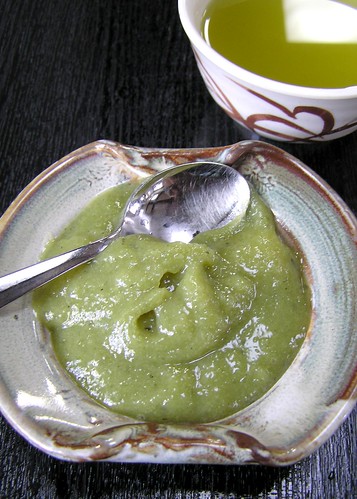Although there are many Japanese sweets that I could happily eat all day, every day, I've been trying hard not to double up. On this occasion, however, there was no way to resist a second helping of kurumi mochi, a treat I'd already tasted up north.
Located in Sakai, a barren suburb of Osaka, and accessible via a rickety tram line, Kanbukuro justly famous for its kurumi mochi, reputedly the favorite sweet of local son and tea ceremony hero, Sen no Rikyu (died 1591). It's hard to explain the odd chill I get from having even such an attenuated bonding experience with a man who always shows up on my Fantasy Dinner Party guest list; imagine being able not only to order Shakespeare's favorite sandwich, but having it prepared by descendants of the very same chef who cut off the great man's crusts. Some people find that looking at the night sky gives them a freeing sense of their own insignificance and, consequently, of their place on the continuum of human existence. What can I say? Mochi is my night sky.
Located in Sakai, a barren suburb of Osaka, and accessible via a rickety tram line, Kanbukuro justly famous for its kurumi mochi, reputedly the favorite sweet of local son and tea ceremony hero, Sen no Rikyu (died 1591). It's hard to explain the odd chill I get from having even such an attenuated bonding experience with a man who always shows up on my Fantasy Dinner Party guest list; imagine being able not only to order Shakespeare's favorite sandwich, but having it prepared by descendants of the very same chef who cut off the great man's crusts. Some people find that looking at the night sky gives them a freeing sense of their own insignificance and, consequently, of their place on the continuum of human existence. What can I say? Mochi is my night sky.
Rikyu's favorite dessert seems to have stood the test of time far better than his neighborhood. Wandering around in an unsuccessful attempt to spot the "ruined Sen no Rikyu residence" marked on my tourist map, I had the eerie and very un-Japanese experience of being the only person on the street. By contrast, Kanbukuro was hopping, with families and groups of friends hopping to get a table before the day's supply of mochi ran out; those who chose to could keep an eye on the ghost town outside via a bank of CCTV monitors mounted disquietingly over the tea urn.



No comments:
Post a Comment